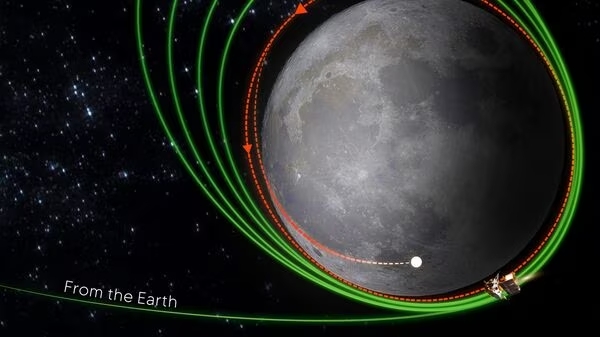Navya Naveli, Pune
The fifth and last lunar-bound orbit maneuver of the Indian Lunar Mission was carried out, bringing the distance to the Moon’s surface closer. The Indian Space Research Organization (ISRO) spacecraft has completed all the movements necessary for its lunar voyage with the help of this accomplishment. The emphasis is now on the upcoming separation of the lander module from the propulsion module, which will include both the Vikram lander and Pragyan rover components.
After the firing on August 16, the lander will separate from the propulsion on August 17. At around 11:52, the spacecraft was in an orbit of 153 km by 163 km. The Chandrayaan-3 will reduce its orbit to a diameter of about 100*30 kilometers over the coming days. If all goes according to plan, the landing will be on August 23 at 5:47 p.m.
The lander is anticipated to undergo the act of slowing down called “deboost” to be in an orbit where the closest point to the Moon, Perilune, and farthest point from the Moon, Apolune, are 30 km and 100 km, respectively. On August 23, a safe and smooth landing attempt will be made from the orbit of the south pole of the Moon. S. Somanath said that ISRO faces issues during the orbit determination for accurately estimating the lander from Earth. Besides that, ISRO doesn’t see any difficulties up to 100 km.
The mission’s objective is to demonstrate a careful and smooth landing on the surface of the Moon. It will also demonstrate the Rover traveling around the Moon and conducting in-situ scientific experiments.
Pragyan, the Rover’s rear wheels, will mark India’s presence by leaving symbols of the ISRO and the national emblem representing the Lion Capital of Ashoka at Sarnath.
The south pole of the Moon is a potential target as it is believed that it has a substantial amount of ice that can be used for extracting fuel, oxygen, and drinking water, but it is a challenging terrain for landing.
The lunar-bound maneuvers are completed by the successful firing for a brief period, which fortunately placed Chandrayaan-3 into the planned orbit of 153 km by 163 km. According to ISRO, as the Propulsion Module and the Lander Module got ready to separate on their respective trips on Wednesday, it was time to make preparations.
The Russian lunar mission Luna-25, launched last week, has successfully entered lunar orbit and is preparing for a smooth landing on the lunar surface between August 21 and 23. It will take 5-7 days to land on the surface of the Moon. This happens as Chandrayaan-3 continues to get closer to landing on the surface of the Moon. Even though the missions will land on the same timeline, they won’t interfere with each other.
